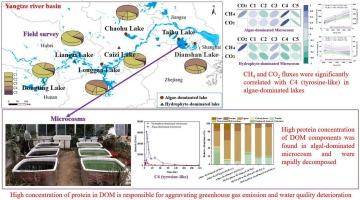从溶解有机质特征看不同生态类型湖泊的污染潜力:实地和实验证据
IF 6.3
1区 地球科学
Q1 ENGINEERING, CIVIL
引用次数: 0
摘要
淡水湖泊中溶解有机物(DOM)的变化对了解水质动态和碳循环至关重要,但驱动这些变化的机制尚不清楚。本研究将6个淡水湖划分为藻类为主和水生植物为主两种生态类型。发现它们的DOM特征有显著差异。藻类为主的湖泊C4(酪氨酸样)荧光成分的分布比例较高。值得注意的是,在藻类为主的湖泊中,甲烷(CH4)和二氧化碳(CO2)的排放通量与酪氨酸类物质呈显著相关。同时,模拟藻类和水生植物分解的微生物被培养来代表这些不同的生态类型。DOM组分特征与野外调查结果一致,傅里叶变换离子回旋共振质谱(FT-ICR MS)分析结果表明,藻类为主的微生物群落蛋白质含量较高,变异较大。拟杆菌门的相对丰度在藻类为主的微环境中始终较高。此外,本研究还发现藻类分解产生的高浓度蛋白质在促进水质恶化中起着关键作用。这些发现阐明了不同湖泊类型中水生植物和藻类分解过程中DOM特征的差异,为有效的湖泊管理提供了有价值的见解。本文章由计算机程序翻译,如有差异,请以英文原文为准。

Insight into the pollution potential of different ecological types of lakes from the perspective of dissolved organic matter characteristics: Field and experimental evidence
The changes in dissolved organic matter (DOM) in freshwater lakes are crucial for understanding water quality dynamics and the carbon cycle, yet the mechanisms driving these changes remain unclear. In this study, six freshwater lakes were categorized into two ecological types: algae-dominated and hydrophyte-dominated. The characteristics of their DOM were found to be significantly different. Algae-dominated lakes exhibited a higher distribution ratio of C4 (tyrosine-like) fluorescence component. Notably, the emission fluxes of methane (CH4) and carbon dioxide (CO2) were significantly correlated with tyrosine-like substances the in algae-dominated lakes. Simultaneously, microcosms simulating algae and hydrophyte decomposition were cultured to represent these distinct ecological types. The characteristics of the DOM components aligned with the field survey results, and Fourier Transform Ion Cyclotron Resonance Mass Spectrometry (FT-ICR MS) indicated that the algae-dominated microcosms contained higher protein content and greater variation. The relative abundance of Bacteroidetes was consistently higher in algae-dominated microcosms. Furthermore, this study identified that the high concentration of proteins produced by algae decomposition played a key role in promoting water quality deterioration. These findings illuminate the differences in DOM characteristics during hydrophyte and algae decomposition across various lake types, providing valuable insights for effective lake management.
求助全文
通过发布文献求助,成功后即可免费获取论文全文。
去求助
来源期刊

Journal of Hydrology
地学-地球科学综合
CiteScore
11.00
自引率
12.50%
发文量
1309
审稿时长
7.5 months
期刊介绍:
The Journal of Hydrology publishes original research papers and comprehensive reviews in all the subfields of the hydrological sciences including water based management and policy issues that impact on economics and society. These comprise, but are not limited to the physical, chemical, biogeochemical, stochastic and systems aspects of surface and groundwater hydrology, hydrometeorology and hydrogeology. Relevant topics incorporating the insights and methodologies of disciplines such as climatology, water resource systems, hydraulics, agrohydrology, geomorphology, soil science, instrumentation and remote sensing, civil and environmental engineering are included. Social science perspectives on hydrological problems such as resource and ecological economics, environmental sociology, psychology and behavioural science, management and policy analysis are also invited. Multi-and interdisciplinary analyses of hydrological problems are within scope. The science published in the Journal of Hydrology is relevant to catchment scales rather than exclusively to a local scale or site.
 求助内容:
求助内容: 应助结果提醒方式:
应助结果提醒方式:


